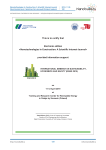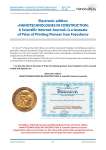Статьи журнала - Nanotechnologies in Construction: A Scientific Internet-Journal
Все статьи: 409
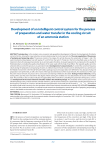
Статья научная
Introduction. In the modern socio-economic and geopolitical development of Russia, the development of industry comes to the fore. Among the many industries, ammonia stations play the most important role. The main regularities of the process of pumping and preparing water. The process consists of six stages, this article discusses the automation of stages 1 and 2: for water treatment and pumping it out with pumps H1 and H2 from the tank P2. Products in the form of purified water are the most important criteria for subsequent production at an ammonia plant, therefore, increased requirements are imposed on the quality of finished products, including the quality of purification of the water used with the help of nanofilters. The required quality cannot be achieved without control the process in an automated mode. Development of a neural network. To control the converters frequency values during the preparation and pumping of water, an artificial neural network must be used. Its development was carried out in the Matlab environment in the Neural Network Toolbox package, input and output data were defined for this, data processing and preparation were performed, as well as the choice of the type and architecture of the neural network. The architecture of the Layer Recurrent neural network, the process of its construction and training in Matlab is described. Testing of neural networks. During testing of the Layer Recurrent network for the degree of their training, the smallest error was obtained for 30 neurons in the hidden layer. The proximity to the set values indicates the applicability of the network for controlling the parameters of frequency converters. Development of the neural network controller model in the Simulink package. The simulation of the control system in the Simulink package using a neural network controller with the Layer Recurrent architecture is performed. Checking the frequencies of the frequency converters H1 and H2 in Simulink for the level parameters in the tanks and in the tank LT1_вх, LT2_вх, LT3_вх showed that the object model works correctly, thus, the simulation of the neural network showed that the training was successful. Conclusion. As a result of the conducted research, an artificial neural network was developed to control the process of preparing and pumping water in the Matlab environment and a simulation of a neural network in the Simulink package.
Бесплатно
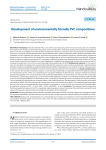
Development of environmentally friendly PVC compositions
Статья научная
Introduction. Polyvinyl chloride (PVC) is one of the most important polymers in the economy. Due to its versatility, this material is now found in a wide variety of products used in everyday life. A wide range of physical and mechanical properties is given to it by the use of additives, the main of which are plasticizers. The most common in terms of consumption are orthophthalic acid esters, in particular, dibutyl phthalate (DBP), dioctyl phthalate (DOP), diisononyl phthalate (DINP), diisodecyl phthalate (DIDP). Phthalates are well combined with polymers, give them high physical and mechanical properties, therefore plastic compounds based on them are widely used in the construction sector, engineering, as well as in agriculture and in everyday life. Numerous studies of products made from plasticized PVC, conducted in different countries, have established the adverse effects of DOP on human health, which led to the limitation of its areas of application. Legislative bans and growing consumer pressure are forcing PVC compound manufacturers to look for an environmentally friendly replacement for DOP. Methods and materials. In this research work, the possibility of creating more environmentally friendly PVC compounds using a mixture of plasticizers: industrial dioctyl phthalate and diisononyl phthalate and dibutoxyethyl phthalate (DBOEP) developed by us was studied. The choice of the plasticizers is based on the fact that DINP and DBOEP, in contrast to dioctyl phthalate, belong to the 3rd hazard class. Results and discussion. In the course of the correlation-regression analysis, a close functional relationship was obtained between the additives used and the characteristics of PVC, which was confirmed by the calculated coefficient of determination. Using the method of nonlinear programming applied to the constructed third-order polynomial dependencies, it was found that in the basic PVC composition formulation it is promising to replace up to 25 wt.h. DOP on DINP plasticizer. The joint use of industrial plasticizers DOP and DINP, as well as the developed DBOEP in the formulation of PVC compositions, indicates an increase in plasticity and manufacturability. This can probably be explained by the synergistic effect of the studied plasticizers. The dependence of the properties and content of plasticizers DBOEP and DINP in the form of a second-order surface was studied on the basis of the obtained experimental data, the level lines of the constructed function of two variables were studied, as a result of which it was found that the greatest effect is achieved at a dosage of: DOP – 25 wt.h., DINP – 5 wt.h. and DBOEF – 20 wt.h. Conclusion. The obtained research results show that the proposed formulation of the PVC composition makes it possible to reduce the toxicity of the plasticizers used by 50 % and improve the physical, mechanical and technological characteristics of the compounds.
Бесплатно
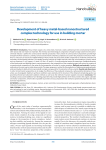
Development of heavy metal-based nanostructured complex technology for use in building mortar
Статья научная
Introduction. Heavy metals (copper, zinc, nickel, lead, chromium, cobalt, cadmium) get into constructional materials with natural and man-made raw materials. The chemical and mineralogical composition of large-tonnage wastes from the petrochemical industry is perfect for constructional materials production. Heavy metals in constructional compositions provide high strength and frost resistance. Currently, nanostructured metal-containing complexes are used in the production of mortars. Therefore, it is necessary to ensure the reliable binding of heavy metals into structurally stable compounds to avoid their emission and secondary environmental pollution. The steadily growing volumes of sludge reservoirs with high concentrations of heavy metals such as chromium (Cr +6), copper (+2), lead (+2), iron (+2), and Fe (+3) cause particular interest to researchers. Qualified extraction of the listed metals and binding them as nanocomponents in the composition of the complexing agent will ensure the creation of a nanostructural composition in the recipe for the preparation of mortar for various purposes. Methods and materials. Sorption methods are the main way to isolate heavy metals. The paper proposes a method for the production of alkyleneaminopolycarboxylic acids and studies its ability to form nanometallic complex compounds for the extraction of heavy metals. Results and discussions. In order to bind metal nanoparticles in oil sludge, the efficiency of the produced compounds, carboxymethyl derivatives of hexamine, was investigated. Optimum synthesis conditions were selected and the structure of the obtained complexing agents was proved by infrared and ultraviolet radiation methods as well as by the method of nuclear magnetic resonance. Conclusion. The resulting nanostructured additions have binding properties that provide high adhesion of the heavy metal to the organic substrate and mortar components, which makes it possible to provide a strong composition that maintains operational properties that meet technical requirements.
Бесплатно
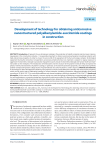
Статья научная
Introduction. At present, the use of polymer coatings in the protection of metallic materials and structures is becoming popular in the construction industry. It is especially important to obtain nanostructured polymer insulating materials with high anticorrosive properties in order to ensure the service life of the equipment of the fuel and energy complex. Technological equipment during the extraction, transportation, processing of petrochemical raw materials is subject to regular exposure to aggressive environments. Damage to production equipment causes annual environmental damage and human health and material burden on the enterprise. The introduction of heteroatoms into the structure of the polymer molecule helps to improve the physico-chemical characteristics of polymer coatings, in particular, to increase the protective properties, since natural and synthetic polymer compounds represent a large cluster of supramolecular structures located in a certain sequence. Methods and materials. A technology has been developed for obtaining new polymeric nanostructured alkenylsuccinimides with anticorrosive properties, which can be used as part of lubricating coatings in various industries, including construction. Alkenylsuccinimides were tested according to TS 38101147-77 for succinimide additives and showed compliance with their standards TS 38101247-77. Results and discussions. In the course of the research a resource-saving non-waste technology of obtaining a nanostructured polymer additive with polyamines as a nanostructuring base to provide an anticorrosive effect has been developed. Conclusion. The obtained compounds based on triethylenetetramine, tetraethylenepentamine, alkenylsuccinic anhydride can be used as effective polymeric anticorrosion additives in the processing of metal materials and structures in the construction industry.
Бесплатно
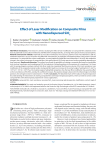
Effect of laser modification on composite films with nanodispersed SiO2
Статья научная
Introduction. This research is aimed at studying the effect of laser modification on composite films obtained on the basis of polyimide track (nuclear) membranes and filled with nanodispersed SiO2; to change their optical and structural properties. Materials and research methods. Polyimide track (nuclear) membranes were used as a polymer matrix. Track diameter is 200 nm, membrane thickness is 25 μm. The tracks were filled with nanosized SiO2 by hydrolysis of tetraethoxysilane in the presence of track membranes. For composite film surface modification, we used ytterbium pulsed fiber laser Minimarker 2-20 A4 PA. We studied the change in the surface microscopy of composite films, their optical density, IR-Fourier spectra and surface wettability depending on laser treatment. Results and discussion. The authors have found the possibility of creating a composite film based on a polyimide track (nuclear) membrane and nanodispersed SiO2 by hydrolysis of tetraethoxysilane in the presence of a membrane. It is shown with the energy dispersive analysis method that silicon oxide has completely filled the pore volume of the track membrane. Laser modification of the composite material surface (composite film) leads to an increase in the contact angle of wetting from θ = 66.75 ± 1.55° to θ = 101.52 ± 3.03°. Thus, the material acquires hydrophobic properties. Also, the laser films modification has a positive effect on the transmittance of the films, namely, this coefficient increases. The greatest change is observed in the infrared region of еmitted spectrum, the average increase in transmission is +70.48%. Conclusion. The obtained results of the study are of great importance for understanding the mechanisms of creating composite films with improved optical properties, which can later be used to create composite films with desired optical properties for various applications.
Бесплатно
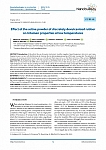
Статья научная
Introduction. In the article the use of powder elastomeric modifier capable of rapid breakdown into micro- and nanofragments upon contact with hot bitumen to improve the low-temperature properties of bitumen is presented. The indicators of resistance to cracking are determined by various methods and their dependence on the thermal history of the samples. Methods and Materials. At temperatures up to –36оC the oscillatory rheological tests (4-mm DSR test) of RTFO-aged samples of bitumen BND 60/90 and modified binder (MB) which contain the active powder of discretely devulcanized rubber (APDDR) produced by high-temperature shear-induced grinding from the crumb rubber of worn tires have been conducted. MB was prepared by mixing bitumen (3 min; 160оC and 600 rpm) with 12.5 wt.% APDDR. Results and Discussion. The effect of the test parameters on the rheological parameters has been studied. Structural transitions in bitumen and MB by methods of differential scanning calorimetry (DSC) and the cracking temperature of the same samples in static conditions in the ABCD test were detected. It is revealed: a decrease in the temperature of actual cracking of the MB sample compared to bitumen. Conclusion. It is shown that APDDR as a modifier affects the structure of bitumen and reduces the temperature sensitivity of bitumen to external influences.
Бесплатно
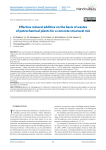
Статья научная
The use of concrete in building allows obtaining reliable and long-lasting operation of buildings, but such conditions require concrete with specified characteristics. Today hardly one can produce a concrete structural mix of high quality without any additives. To control actively the structure and properties of a concrete mix and concrete, along with chemical additives, mineral additives are used. The mineral additives are the powders of various mineral nature, obtained from natural or man-made raw materials: ground slag, rocks, etc. The article introduces the method of obtaining a mineral additive for a structural mix, in particularly for concrete. Qualitative characteristics of the additive obtained were studied as follows: the index of the degree of grinding to be equal to 1, standard consistency (normal density) – (180±5) mm with a mass ratio of «additive: water») – 100: 70, setting time – beginning 20 min, water absorption 0.27%, water content 9.65%, the proportion of insoluble residue in hydrochloric acid solution is 1.70%. Implementation of the additive in the concrete composition has shown that the quality of the product does not fall, and the actual strength is 250.7 kgf/cm2, which is slightly higher than the strength of the concrete sample without an additive. It was determined that the quality of concrete products with a mineral additive corresponds to GOST as follows: density 1775 kg/m3; mass humidity 0.3%; volume humidity 0.5%. The introduction of a structural mix will significantly improve the properties of a concrete structural mix and will also reduce the fuel resources consumption for production of the concrete structural mix, products and constructions of its basis.
Бесплатно
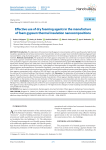
Статья научная
Introduction. The elaboration of foamed eco-friendly gypsum nanocomposites with low specific gravity, high thermal insulation, operational and technical and economic characteristics remains an urgent task. Controlled hardening of gypsum foam nanoassemblers using dry foaming agents is a promising direction in the technology of production of heat-insulating building materials. Methods and materials. The production of a foam gypsum composition was carried out in an ejector-turbulent mixer by mixing a gypsum nanobinder with functional foaming nanoadditives. Building gypsum G5 BII was used as a binder in the work; porization of gypsum compositions was carried out using an adsorbed foaming agent PBNS. Results. The transformation of liquid-phase foaming agents into solid-phase ones by binding water allows the production of gypsum foam compositions from dry mixtures, which gives high dosing accuracy, a good degree of homogenization of components and stable characteristics of foamed gypsum nanocompositions. In production conditions, a one-storey small-sized pavilion was built using a pilot 3D printer AMT S1160, in which vertical enclosing structures are filled with foamed heat-insulating nanostructured foam gypsum. Monolithic foam gypsum nanomaterial with a density of 300–400 kg/m3 was used for insulation and sound insulation of attic floors during the overhaul of the historic building of the Veterans Hospital in Ufa. Discussion. The elaboration of technology for obtaining foam gypsum from dry mixtures is based on the advantage of manufacturing and using thermal insulation nanocompositions, which allows for significant punctuality of dosing and stable characteristics of foam gypsum building materials. Surfactants have a significant effect on the kinetics of the structure formation of the foam gypsum nanocomposition and slow down the coalescence of air bubbles. Conclusions. Nanoporous foam gypsum concrete, obtained as a result of controlled hardening, with a density of 400 kg/m3 has a thermal conductivity of 0.12 W/(m•ºС) and a compressive strength of 1.4 MPa. The compressive strength of foamed foam gypsum using a dry foaming agent on sorbents is 17% higher than the strength of a heat-insulating nanomaterial prepared using traditional technology.
Бесплатно
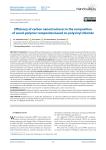
Статья
Introduction. The most effective binding agents in wood-polymer composites based on polyvinyl chloride are carboncontaining nanostructures, which improve the electrical, physical-mechanical, rheological properties, as well as the structure and durability of the composites. Their main disadvantage is a high degree of particle aggregation, which makes it difficult to mix and process them in polymer compositions. In this regard, an urgent task is to search for such carbon nanomodifiers that would have a low degree of aggregation and low cost. Methods and materials. The paper studies the effectiveness of mechanically activated petroleum cokes as binding agents in building wood-polymer composites based on polyvinyl chloride. Mechanical activation leads to the functionalization of carbon particles of coke with the formation of oxygen-containing groups on the surface. The effect of various amounts of coke (up to 10% of the mass of wood flour) is considered and the relationship between the nature of coke and their concentration in the polymer compositions with the main technological (melt flow) and operational (tensile and bending strength, high elasticity modulus, hardness, water absorption and thermal stability) indicators and supramolecular structure of woodpolymer composites has been identified. Results and discussion. With the introduction of cokes, a high degree of orientation of the supramolecular structures of the composites in the direction of extrusion of the samples is observed, which leads to an increase in the breaking strength and bending strength, as well as the high elasticity modulus. The optimal concentration of additives was determined from 0.1 to 5%. In relation to wood flour, the amount of which in the wood-polymer composition is 50 mass parts per 100 mass parts PVC. Conclusion. The introduction of mechanically activated petroleum cokes as binding agents in wood-polymer composites based on polyvinyl chloride has been carried out. Mechanical activation made it possible to reduce the aggregation of coke particles into larger agglomerates, which makes it possible to efficiently introduce the nanomodifier in dry form and to exclude the introduction of nanomodifier in the form of aqueous dispersions, which is a rather energy-intensive production operation.
Бесплатно
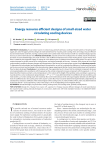
Energy resource efficient designs of small-sized water circulating cooling devices
Статья научная
To use natural sources in rational way, plantsof continuous cooling of closed systems of recycling water supply are used. The paper presents designs of small-sized devices for recycling water cooling which are energy resource effective due to twisted motion of air flow, moving countercurrent to the cooled water. Heat and mass transfer is a nanotechnological process that occurs at the intermolecular level. Methods and materials. Countercurrent mini cooling towers are widely used in all industries, but there are some disadvantages, the main of which is the insufficient interaction time of the moving phases. Screw motion of air flow is created by the tangential supply of cooling air in the bottom part of cylindrical small-sized cooling tower. The rate of rotary motion decreases as air flow moves up in cooling towers, and vertical parameter of the rate – increases. Such scheme of the air flow motionmakes it possible to decrease average vertical parameter of the rate and to increase phases contact time. Laboratory research. To determine the technological and hydroaerothermal characteristics, as well as to estimate the efficiency of cooling recycled water, and to carry out mass-heat exchange at the intermolecular stagean experimental facility of small-sized cooling tower with twisted air flow has been developed. Conclusions. In accordance with the exponential law it is shown that the rotational component decreases at increasing height, and in accordance with the power law the vertical component increases component with the exponent ~1,79. It is determined that moisture content x and air temperature tv in the volume of the height of the sprinkler varies according to a power law, in particular for a screw cooling tower proportionally x ~ h0,83, tв ~ h1,25. It was determined that the coefficients of mass transfer βxv and heat transfer αv of a mini cooling tower with twisted air flow at the intermolecular level with equal irrigation densities are 20% higher than the coefficients of a mini cooling tower with counter-current flow. Also it has been determined experimentally a dependence of aerodynamics resistance coefficient of the twisted irrigator of the cooling tower on criterium Refor air flow, and it was determined that it decreases like Re–K2 as the exponent K2 varies in the range 0.114÷0.193 depending on the irrigation density.
Бесплатно
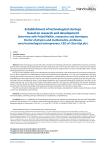
Статья научная
Today technological communities often consider lack of funding and ideas for establishment of startups as the biggest hitch for launching and development of innovative startups for the moment. But that seems to be unsound as the statistics says that there are plenty of financial institutions, venture funds, business angel investors as well as incoming offers from startups showing that there is a host of ideas. One of the most significant tasks in the international technology community is the development of technology entrepreneurs who are able to approach the establishment of their technological startups insightfully. As a rule, such entrepreneurs launching startups are focused on the process of design and development of a unique device, software and other products which they find outstanding, and only after that such issues as: who needs this product and how this product is going to be built into the manufacturing chain are considered by them. A technology entrepreneur with strong technology skills should direct his efforts to the market and end user. In the USA, Israel, Canada and European countries, this function is performed by the inventor, developer, scientist. Therefore fostering of skills of technology entrepreneurship is a very significant factor which allows inventors, developers and scientists to get basic knowledge of entrepreneurial activities and realize their own ideas at early stages. We will try to answer the basic questions which allow scientists, developers, and engineers to build a successful business based on their own developments and research.
Бесплатно
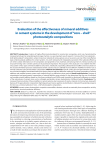
Статья научная
Introduction. Creation of highly efficient photocatalysts for construction composites, which are characterized by increased activity and an extended spectral range of action, is a very important area of research. It is known that “core (substrate) – shell (photocatalyst)” compositions, where mineral raw materials of various genesis can act as carriers, are one of the most effective types of photocatalytic additives for cement systems. It is worth noting that for integrated assessment of the substrate efficiency, we need to obtain information on the composition and properties of raw materials used among which its chemical activity and structure-forming role in cement systems are of paramount importance. The purposes of this study are (1) to establish the influence pattern of four types of mineral additives (silica fume, metakaolin, expanding sulfoaluminate modifier and microcalcite) on the structure formation processes of plasticized cement systems and (2) to identify the most effective modifiers for further use as mineral substrates in the photocatalytic compositions. Methods and materials. Specific surface area and granulometric composition of mineral modifiers were determined by the Kozeny-Karman and laser diffraction methods. The phase composition of mineral additives and modified cement systems were studied using X-ray diffraction phase analysis. Results and discussion. Features of mineralogical and granulometric compositions of mineral additives were revealed. It was determined that the use of individual and complex mineral additives based on silica fume, metakaolin and ESAM made it possible to directionally influence on content of the main phases of cement stone such as ettringite, portlandite, calcium hydrosilicates of different basicity. Conclusions. The increased chemical activity of these modifiers in cement systems, due to presence of reactive minerals in the structure, along with features of the granulometric composition (high dispersity and narrow particle size distribution), indicated the potential prospects for their use as mineral substrate in “core – shell” photocatalytic compositions.
Бесплатно
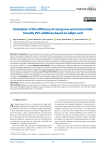
Статья научная
Introduction. The economic activity of a person entails environmental, economic and social damage to the environment. The production of goods or services is associated with the consumption of natural resources and emissions that negatively affect the ecological state. Currently, there is an acute problem of the negative impact of man on the natural environment and is the main source of deterioration in the health of living beings. In modern conditions, chemical safety is one of the priority tasks of socio-economic development. To protect the environment, it is important to take appropriate measures and develop appropriate mechanisms to promote sustainable development. For this purpose, an assessment of the environmental and economic damage from human activities is required. Materials and methods. The work employs the method for determining the prevented environmental damage, approved by the Chairman of the State Committee of the Russian Federation for Environmental Protection, to perform ecological and economic assessment of the environmental impact of new environmentally friendly biodegradable additives for polyvinyl chloride based on adipic acid. Results and discussion. Polymeric materials, as the most popular and widespread, make a significant contribution to the deterioration of the environmental situation. In this regard, the main values of the prevented environmental damage from soil degradation were calculated when using new environmentally friendly additives for PVC based on adipic acid. Conclusion. The introduction of the developed additives into the composition of the developed additives provides economic and environmental efficiency in order to accelerate the biodegradation of polymer composite materials, protects against chemical pollution by hazardous toxic compounds and helps prevent soil degradation.
Бесплатно
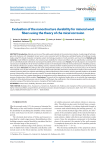
Статья научная
Introduction. Mineral wool is one of the widely used materials in the construction industry. A wide range of technologies and structures with integrated mineral wool is also connected with the following: ventilated facades of buildings, facades made using FICS (facade insulation composite system) technology, insulation of roofs and attics, and much more. Methods and materials. Under different conditions, the nanostructure durability for mineral wool fibers will vary significantly. Currently, there are no scientifically based methods for assessing the durability of the nanostructure. Results. The article proposes to evaluate the nanostructure durability for the of mineral wool fibers based on the developed method of chemical destruction of building ceramics. The methods of laboratory analysis of the building ceramics material and their modernization for the nanostructure of mineral wool fibers are given. Discussion. According to the results of experimental studies, it was found that the corrosion process in the mineral wool material occurs by the mechanism of reaction of alkali metal hydroxides with silicon and aluminum oxides in the mineral wool material, removing them into solution and leading to chemical destruction of the material, which is generally similar to the studied process of destruction of the wall ceramics material. The results obtained allow us to conclude that the process of chemical destruction of mineral wool has a greater dependence on temperature and less dependence on the concentration of hydroxides than the process of destruction of brick material. Conclusions. The results of the conducted studies allow us to calculate the temperature coefficient of the destruction process rate in the Van't-Hoff formula, the coefficients in the Arrhenius equation and the value of the activation energy of the destruction process. Examples of field studies are given.
Бесплатно
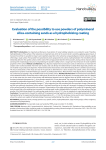
Статья научная
Introduction. An important performance characteristic of many building materials is one related to water. Therefore, hydrophobization of the surface of the material is an important task, which at the current level is solved by applying special means. It has been found that it is possible to impart water repellent properties to the surface by using polydisperse mineral materials capable of forming a rough surface. Fine powder from polymineral sand is proposed to be used as a hydrophobisate. The revealed functional relationship between the specific surface and the value of the average particle diameter of the powders, having a linear character, allows assessing their morphological structure and predicting the powder's ability to form a rough layer that enhances the water repellent properties of the surface. Methods and Materials. Four deposits of polymineral construction sands are selected as raw materials. The samples were washed and dried. Then their size modulus and true density were determined. To obtain finely dispersed powders, the raw material was ground by dry dispersion. Particle dimensional characteristics were determined by photon-correlation spectroscopy. The visual characteristic of the shape and size of the particles is determined on a laser analyzer. The specific surface area of highly dispersed rock systems was determined by gas sorption, according to BET theory. Measurement of the edge stationary wetting angle was carried out by applying a drop of distilled water to the powder surface. Results and Discussion. The dimensional characteristics of the obtained fractions showed that with a milling time (30 min) for the sands of all deposits, the average particle size (d) is 360±45 nm. At the same time, the sands of the Kenitsy and Nekhtskoye deposits have the highest values of specific surface area (Ssp). The functional relationship between the Ssp of the powders tested and 1/d was determined. The resulting linear dependencies were characterized by mathematical expressions of the form Ssp = (a/d)+b, a where reflects the rate of change in the specific surface value as the average particle diameter of the samples changes; b – is the regression line shift associated with the asymmetric shape of the particles and the non-uniformity (roughness) of the surface. It has been found that as the value of b increases, the degree of inhomogeneity of the surface formed by these particles also increases. Determination of the edge wetting angle of the surface of the powders under study showed that as the grinding time increased, the wetting angle (surface hydrophobicity) increased. So, for the surface of the fine powder of the Nekhtskoye deposit, the wetting edge angle reaches a value (114о) close in magnitude to superhydrophobicity (120о). Conclusion. The experiments showed the validity of the proposed working hypothesis related to the possible assessment of surface hydrophobicity by the experimentally determined dependence of Ssp = f (1/d). This technique can be used to select mineral powders whose fine systems are capable of hydrophobizing (if necessary hydrophilizing) the surface of the material.
Бесплатно

